We continue our series of posts on email marketing. This time, we will talk about the ways of accumulating a subscriber mailing list. It’s a very important thing to do since emailing is a much better way of sharing information than SMS or phone calls (with a talking robot or manager). Besides, the subscriber database is fully yours. (You cannot say the same about Facebook, Twitter, Pinterest and other social networks where you have to fight for the audience's attention). You can bring the audience back to the website, cultivate client loyalty, inform about new products/services, and share your stories about some funny incidents.
Of course, it is easier to find or buy a database, but keep in mind that sending people letters they don’t want to receive is spam. That’s unethical, and even illegal, so it is better to create your own email list. There is a popular belief that no one reads email newsletters. However, I would say that it all depends on their quality. If there is nothing but advertising and a particular person is not interested in it — then it is quite clear why he/or she doesn’t want to read it. Nevertheless, I bet that if you do not like to overpay for tickets, you closely follow all of the airlines’ mailings. The top class for enthusiasts – are email newsletters from the cities that have multi-million databases. It’s been a couple of years since I started reading the Berlin Sugarhigh (“bilingual daily email-magazine”), which has a very cool copywriting and non-intrusive advertising of interesting venues and activities.
1. Convenient Subscription Form
To make the subscription form more effective — it’s necessary to conduct the A/B testing. It’s possible to use services such as Optimizely and Visual Website Optimizer. You should test the calls to action as well as button’s shape, color and size. For example, you are running a SEO blog. You can arrange it for 50% of the audience to see your original subscription form, and the other 50% — the modified one. For example, in the first version the form contains a call to "Sign up for my email newsletters," and the second to "Get weekly tips and SEO gimmicks!”. Several thousand actions performed by visitors will eventually show which form works better. Remember to test the parameters in turns to know exactly which one is more effective.
2. Run Giveaway Contests
Here are some relevant examples: 
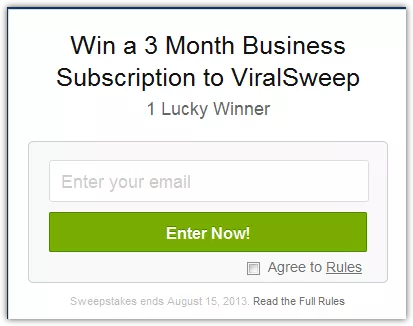
3. Regularly Publish Useful Content
If you have a contextual project, then in order not to miss the updates the users themselves will subscribe to the newsletter. However, it wouldn’t go amiss to add the newsletter subscription form at the end of each post on the blog (online articles).
4. Offer Free Useful Content
You can email "white papers" to those who ask for them or hold a training course via email (send a number of issue-related emails). 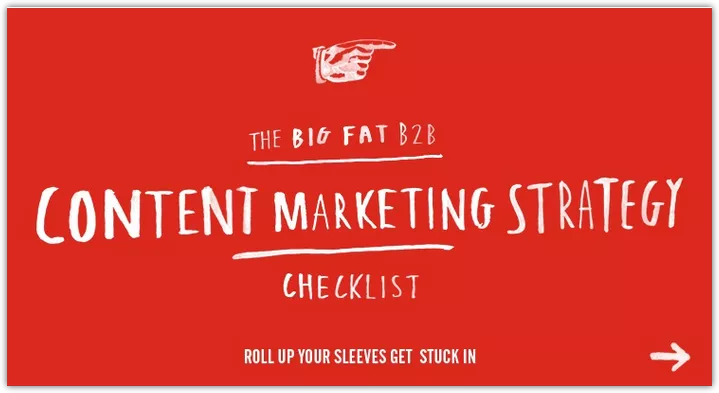
5. Conduct a Webinar
There are a lot of services for the organization of webinars, for example — GoToWebinar. The participants will register using their emails. Not all of them will eventually attend the webinar, but it’s possible to send them a recording and keep the dialogue open (or rather, a monologue by interests).
6. Free Tools / Services
Create a useful service which requires entering users’ emails. 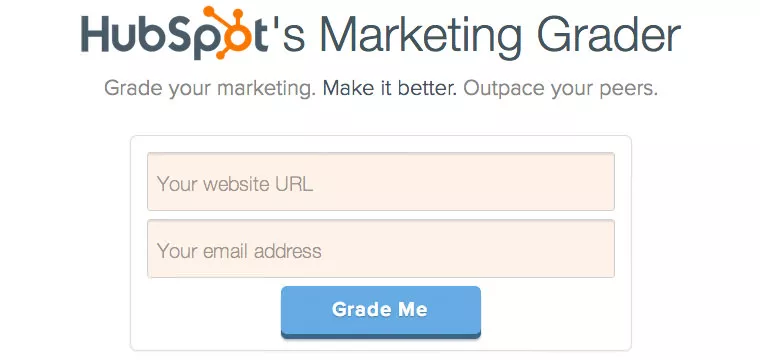
7. Add a Subscription Form to the Facebook Tab
The MailChimp has a special plug-in for this. No one will look for the desired subscription tab on Facebook — from time to time you will have to make posts with reference to it. To make it work, you need to promise Facebook fans something exclusive.
9. Distribute Your Content
If you write something super useful, but only a dozen of your colleagues are reading it – consider it gone — subscriber database will not grow. Try to place guest posts on other blogs. It is important to choose a popular theme blog, where your potential target audience is. Guest posts should not contain too much advertising — on the contrary, they should bear useful information making the readers visit your website to find out more. You can agree upon adding a newsletter subscription form at the end of the post.
10. Attract Audience's Attention
On websites, you can often see a header line text with a call to action — it seems to be a good idea :) 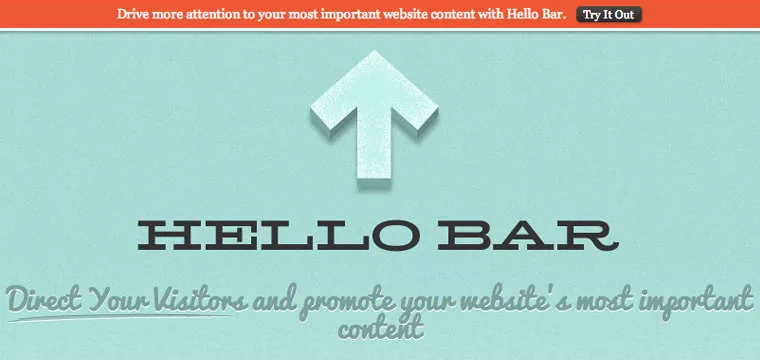
11. Form Right Expectations
Many are afraid of showing their email-addresses, because they are afraid of spam. Furthermore, almost every person has two private emails (one for different registration stuff and another one for letters only. However, this is no longer necessary with the latest Gmail innovations). It's better to make everyone aware that you usually write once a week and only with regard to case.
12. Advertise in Partner Newsletters
It is possible to agree with your partners on sending email newsletters in order to advertise and fill up your email database. It’s also necessary to pay attention to the top information resources in your niche (portals, blogs, online magazines) — usually, it’s possible to get into their email lists (as well as into the social networks communities).
13. Create "Opt-in" Page
These pages have a more accurate name: squeeze pages. In essence, these are the
14. Use Pop-Ups
Groupon, Living Social, Gilt and many other services have collected their databases with the help of pop-up windows motivating users to leave their email-addresses. 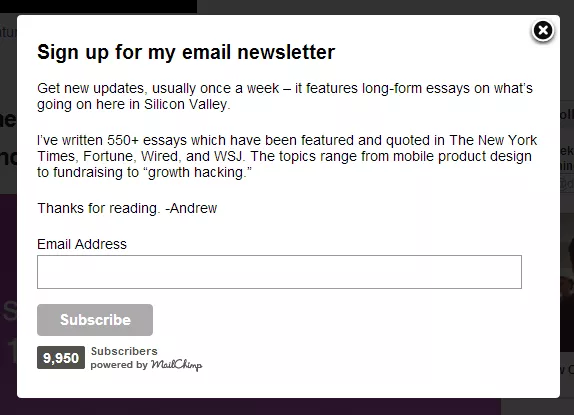
As well, it is possible to provide access to the content only after the email subscription. Here is an example:
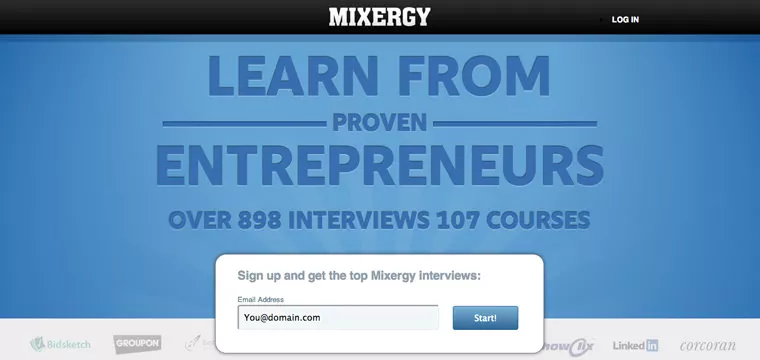
15. Ask to Forward Your Newsletter to Colleagues
If you already have a list of subscribers – you might just ask them to send the newsletter to those colleagues and friends who might be interested in your services. Of course, only the most loyal customers will do it, but it is their recommendation that will lead to the higher conversion rate. By the way, don’t forget to add a subscription button to the footer.
16. Offers Discounts/Coupons
Offer a discount or a coupon in exchange for email addresses. Online stores can motivate customers by providing registered users with 5% discount. Anyway, if someone registers in order to make use of such offer, it means that it’s your potential customer.
In fact, those with email accounts said that receiving discounts and special offers (58%) was the top reason for subscribing to emails. © Chadwick Martin Bailey
17. Collect Email Addresses Using Video
Video – is a great way to attract attention, but if you still don’t know who your audience is, it means that you're missing out on something. Use Wistia and LeadPlayer to embed subscriptions forms into the video.
18. Social Proof
Imagine that you are offered to try a new skin care product. You are not sure that this is an effective product and don’t want to waste time and money falling under the ad’s influence. You start looking for reviews of friends/acquaintances/random people from the Internet to make a decision. If your newsletter has many positive reviews/feedbacks – this will ultimately influence the number of subscriptions. Reviews can be shaped into quotations and placed on the Landing page or, it’s also possible to publish them on social networks from time to time. You should constantly monitor the reviews and use them in your best interests — make sure that as many people as possible will read them. And some extra information from Elizaveta Grudinkina (Managing Director of SendPulse):
Email — is definitely a powerful tool to attract and engage the audience, you just have to learn to get it done.
Related Articles
Display Advertising Effectiveness Analysis: A Comprehensive Approach to Measuring Its Impact
In this article, I will explain why you shouldn’t underestimate display advertising and how to analyze its impact using Google Analytics 4
Generative Engine Optimization: What Businesses Get From Ranking in SearchGPT
Companies that master SearchGPT SEO and generative engine optimization will capture high-intent traffic from users seeking direct, authoritative answers
From Generic to Iconic: 100 Statistics on Amazon Marketing for Fashion Brands
While traditional fashion retailers were still figuring out e-commerce, one company quietly revolutionized how U.S. consumers shop for everything from workout gear to wedding dresses



